
|
|
5 December, 2001
I'm sorry I haven't written for the past few days. I've been out in the field on our "shakedown".
This gives us the opportunity to test out our gear (and ourselves) before we actually go out in
the field for a longer length of time. Normally, people who come to Antarctica must attend "snow
school" or what they call here, "happy camper school". This, too, involves an overnight stay in a
tent or igloo.
Apparently, I'm not part of a "normal" team of Antarctic scientists. Instead, we were taken on our
own private two-day "shakedown" with two field guides and two safety officers (just like the ski
patrol we have at ski resorts). This was not "happy camper school" where they build igloos, pitch
a tent, and sleep overnight. I think it's going to be very hard for some of you to believe what I
have done in the last two days. Hopefully, I'll be able to load pictures soon, and prove it to
you.
Prior to our "shakedown" we had to pack provisions for 6 weeks out in the field. That involved
trying to figure out how much each team of two would need for 42 breakfasts, lunches, and dinners.
It took us a couple of hours to pack up just the dry goods. It included 160 packages of hot
chocolate, 200 chocolate bars, 300 juice boxes, 42 packets of oatmeal (for my breakfasts), 42+
packets of tomato soup (for my tent mate, Nancy's, breakfasts), 20 packets of dry milk, 30 rice
and pasta packets, boxes of potato flakes, 24 steaks, 5 pounds of hamburger, 5 pounds of sausage,
4 pounds of cheese and cold cuts, 3 dozen flour tortillas, 12 packets of "dehy" dinners
(dehydrated
dinners-in-a-bag), and much more.
Once the food list is returned to us, I'll share it with you, but as you can see, most of the food
is dehydrated. The food can be stored for a long time, and it is much lighter to transport. It's
very similar to back-packing food you can buy at the sport shops, but a lot of it (like Oreos, Fig
Newtons, salt, pepper, Cadbury bars, etc.) is the same kind you can buy at the local market. The
total weight of food for the 8 team members must have been close to 1,200 pounds!
For our shakedown, we were asked to pack one separate box containing enough food for two
breakfasts, 2 lunches and 2 dinners. We were also given "sleep kits" containing a sleeping bag,
two foam pads, 1 therma-rest pad, a sleeping bag liner, and a folding seat (no legs). Each team of
two was also assigned a cook box (containing pots and pans, cooking and eating utensils, paper
towels, zip-lock
bags, dish soap, and rolls of toilet paper. (More about that later!) In addition, we received 3
little stoves (which use white gas), a fire extinguisher, matches, and a type of fire starter.
Early Tuesday morning we met at the BFC (Byrd Field Center) wearing our entire set of ECW (extreme
cold weather) gear (long underwear, fleece layer, wind bib, field parka, neck gator, goggles, cap,
gloves, thermal socks, and bunny boots). I felt like the Pillsbury doughboy! We also had to carry
a spare bag containing a spare pair of long underwear, gloves, socks, hat, and jacket . . . just
in case. We also were able to take a few personal arcticles including sunscreen, lip balm, cameras,
journals, etc. But whatever extra we chose to take, we had to carry. Imagine carrying a heavy bag
dressed as the Pillsbury doughboy!
The morning was exciting. We loaded our gear onto long plastic snow sleds, and attached them to
our skidoos (snowmobiles). We each had our own snowmobile, and we were given our first
snowmobile-driving lesson as we snowmobiled about 15 miles out into the field. We passed "happy
camper school" and the remains of their igloos and continued up into the hills where we learned
how to lean our
bodies uphill while traversing across the hill so that we don't tip over, and how to use the brake
when you start moving too fast going downhill. We were also told how to identify possible crevasse
areas, and basically, how to safely traverse an icy area. Yep, I was scared, but this was nothing
compared to what was to come.
Riding on a skidoo through Antarctic landscape is unreal. It truly is out of a dream or picture
book. The area is beautiful! When you think you've seen something amazing (like blue ice hills),
you see something more amazing (like Mt. Erebus with its plumes), then far off in the distance is
another set of mountains, even more amazing than the ones you've just passed. It just didn't seem
"real". I named my skidoo "Charlie", and we did fairly well after the initial fear except when we
were back-ended by a zealous driver when my engine died. All is well, just sore.
Once we reached our campsite, about 10 miles from the base of Mt. Erebus, we pitched our tents,
had a snack of granola bars and chocolate, and set off for "field school". This involved
snowmobiling to another beautiful site where we learned to use the knots we had learned the day
before. We were outfitted with harnesses, crampons, carabiners, prusiks, and a snow ax. We were
told we were going to practice traversing through an ice field and would continue tomorrow with
how to save a person who has fallen into a crevasse. At this time, I was getting a little worried.
(As most of you know, this is my very first "camping" experience.)
Our wonderful field guides, John and Jamie, led us a mile or so downhill to what turned out to be
a *real* crevasse field. We were taught how to walk harnessed to each other, and how to check for
crevasses while we were walking. We actually came across two crevasses! The first, was very wide
(2-3 feet). As I poked my ice ax through the snow, it went completely through, and only served to
make the "crack" wider. I really thought we'd go around it. But crevasses are also very long
"cracks" in the ice. They actually can go on for miles. We had to jump it! Although I was tethered
to two other people, it was still very frightening. I really didn't want to jump holding my ice
ax, but I was told I had to have it (in case I fell I could use it as an anchor to stop my fall).
I decided to count to three and jump/fall to the other side. Thankfully, I made it.
We continued on and found another crevasse (not as wide) and jumped over that one easily.
Needless, to say, I made sure to only step in the leader's footprints. I did not want to discover
a crevasse the "hard way". We came to our final destination at the top of a hill where our field
guide, John, decided to throw an emergency situation at us. He simulated falling into a crevasse,
and we had to determine how to save him. After scrambling for a few minutes (and getting "hints"
from our second guide, Jamie), we were able to assemble a pulley system, and we pulled John out
about 30 minutes after he fell. In a real situation, I don't think we would have been in time.
With the simulation over, it was time to head back. Remember how I told you we had traversed a
mile or so "downhill"? Well, it was now time to traverse back "uphill". Imagine the Pillsbury
doughboy trying to walk uphill in 10 pound bunny boots through foot deep snow that at times
covered crevasses that he had to jump? That's how I felt. I didn't think I would make it.
Fortunately, I did. It seemed to take "forever", but we were once more back on our snowmobiles and
headed back to camp in time for an 8pm dinner break.
Day #2 . . . in my next journal entry.
__________________________________________________
Do You Yahoo!?
Send your FREE holiday greetings online!
http://greetings.yahoo.com

Our guides, Jaime Pierce and John Schutt, checking out our gear for the "shakedown".
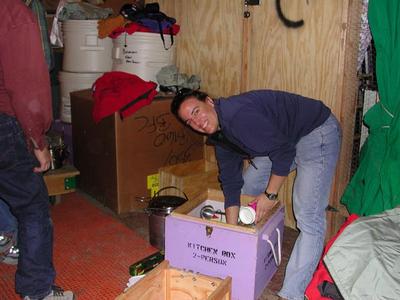
Nancy packing up our "kitchen box".
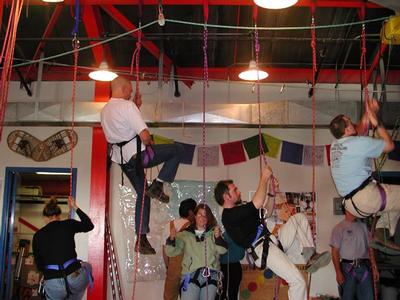
"Ropes" training before our "shakedown".
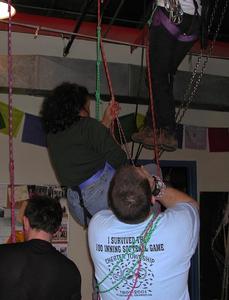
That's me (in the back) on my way down the rope.
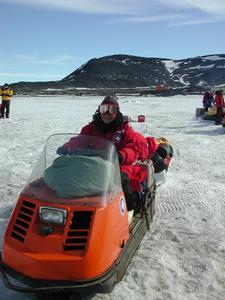
On my skidoo, "Charlie", ready to go!
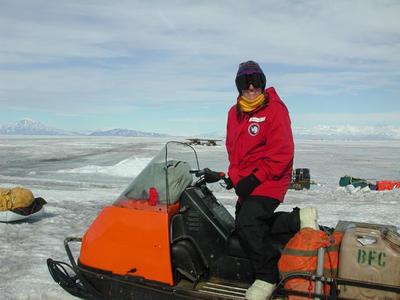
Nancy on her skidoo.

A look at the "happy camper" igloos.

The view inside an igloo.
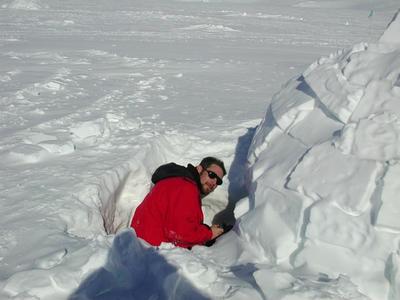
Matt on his way inside!
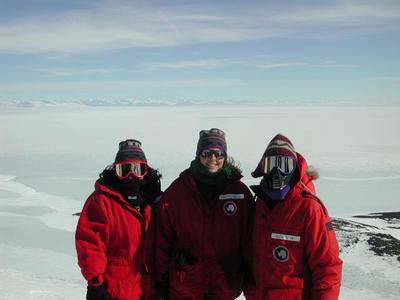
A stop at Castle Rock.

The view from Castle Rock.
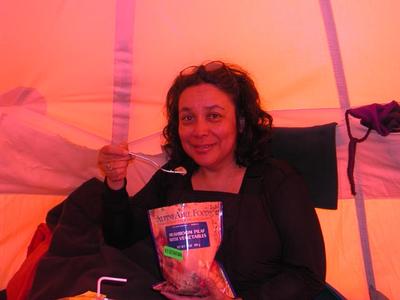
Dinner time! Mushroom pilaf with vegetables for Juanita.
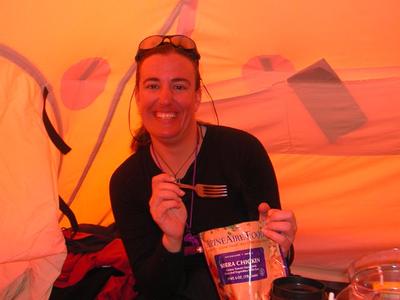
Sierra chicken for Nancy. Notice our (cook-and-eat-in-the-bag) dehy (dehydrated) meals. Yummy! (not really)
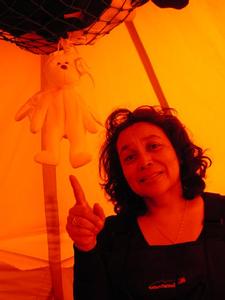
Saying "good-night" to Halo, the angel bear. Halo was a gift from my student, Julia, who felt I needed someone to "watch over me". Thank you, Julia. Nancy thanks you, too.
Contact the TEA in the field at
.
If you cannot connect through your browser, copy the
TEA's e-mail address in the "To:" line of
your favorite e-mail package.
|
